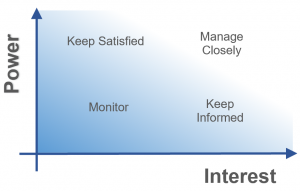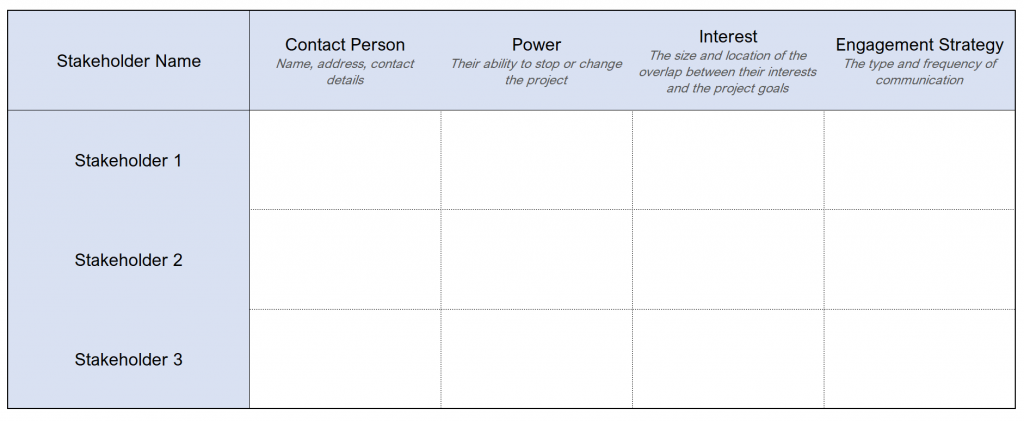
Stakeholders are to a project like players are to a team. Having the best players is one of the easiest ways to win the game, but strategy and tactics led by the coach (project manager) can go a long ways.
Thus, successful projects know who their stakeholders are and what motivates them. That’s where stakeholder analysis comes in.
What is a Stakeholder Analysis?
A Stakeholder Analysis is a tool used to obtain a deeper understanding of a project’s stakeholders in order to develop targeted communication plans that ensure project success.
Why You Need a Stakeholder Analysis
A good stakeholder analysis ensures that all of a project’s stakeholders are being adequately consulted in the most effective ways and thus remain supportive of the project (or increase their support level).
How to Use a Stakeholder Analysis
A stakeholder analysis is consulted in the development of stakeholder communication plans and should be reviewed on regular intervals to ensure its continued relevance in light of changing stakeholder priorities and business goals.
What Does a Stakeholder Analysis Look Like?
A Stakeholder Analysis consists of a document that identifies each project stakeholder and describes their underlying motivations, as well as several charts that categorize and prioritize the stakeholders in standardized ways. These are used to develop stakeholder engagement plans.
Steps of a Stakeholder Analysis
Stakeholder analysis contains the following steps:
- Identify Roles and Responsibilities
The stakeholder’s role, such as Coordinating Party, Funding Agency, etc. provides a good general idea as to how they should be treated. - Quantify power
Power is the stakeholder’s ability to influence a project. This ranges from total control, for example a government regulatory agency, to a minor stakeholder that has little influence. - Quantify interest
Interest is the stakeholder’s level of concern about the project. This also ranges the full gamut from someone who incurs large losses as a result of the project to someone for whom it has a tiny impact. - Specify Key Interests and Underlying Concerns
The stakeholder’s main concerns are documented. Any other subsidiary concerns and underlying motivations are brainstormed and itemized. - Identify Changes Necessary to Power and Interest
Some stakeholders need to change their status in order to produce project success, for example a local landowner that is opposed to a development. - Map stakeholder connections to project tasks
Each project task is inspected and each stakeholder designated on the RACI (pronounced “racy”) scale:- Responsible for it
- Accountable for it
- Consulted about it
- Informed of it
- Create a stakeholder engagement plan
This plan specifies how the stakeholder will be communicated with, how, and how often.
The Stakeholder Engagement Plan serves as a master guiding document that ensures the stakeholder is adequately consulted and is used in project control. That means that on regular intervals the project manager reports on how the plan was implemented, what the results were, and if changes to the plan are necessary.
Stakeholder Identification
Before stakeholders can be analyzed, they must be identified. It is remarkably easy to overlook a small stakeholder who’s ability to derail the project becomes disproportionately large when they are not adequately consulted. Don’t give the ball away early in the game else you will have a mountain to climb.
A stakeholder register is developed and updated regularly with stakeholder changes. Here is a quick checklist to help identify project stakeholders:
- Executives are stakeholders from the parent level organization, including the project sponsor.
- Customers pay for the product or service (the deliverables) the project produces.
- The Project Team produces those products and services.
- Technical / Department managers provide expert advice and resources to the project.
- Lenders, creditors, and investors provide financing to the project.
- Suppliers provide external products and services.
- Governments produce regulations the project must abide by, and issue permits and approvals.
- Local committees and boards approve the project’s deliverables.
- Unions negotiate for better working conditions and pay for the project team.
Power and Interest
If you don’t know where the goal line is, you don’t stand a very good chance of winning the game.
There are two primary variables which define stakeholders and how they influence the project.
- Power is the ability of the stakeholder to change or stop the project.
- Interest is the amount of involvement the stakeholder has in the project. It is the size of the overlap between the stakeholder’s and the project’s needs.
For this reason, the most common stakeholder analysis technique is a power-interest matrix. This chart might seem very simple on the surface, but provides a volume of information about a stakeholder and how to manage them.
 It contains the stakeholder’s interest level on the x-axis, and the power level on the y-axis.
It contains the stakeholder’s interest level on the x-axis, and the power level on the y-axis.
The four quadrants where each stakeholder lies each have different management characteristics.
- Those with low power and low interest must by monitored to ensure that they are not able to stop or change the project.
- Those with high power, low interest must be kept satisfied to ensure that a minor stakeholder doesn’t derail the project.
- Those with low power, high interest must be kept informed to ensure they are on side.
- Those with high power, high interest must be actively managed as they have a major influence on the project.
For example, a government regulatory approval agency might have very high power, but very low interest in the project. They must be kept satisfied or they might withhold permits. Likewise, an environmental protester might have very low power, but high interest. They must be kept informed so that they do not mobilize excessive resistance.
The power-interest matrix contains simply a dot that shows where the stakeholder sits on the chart. A larger stakeholder analysis matrix can expand on the definitions of where that power comes from, how they exercise it, and what their interest in the project is.
 The Stakeholder Analysis Matrix template gives you a few words to describe the power, interest, and engagement strategy, which is a little bit more information than the power-interest matrix. But many projects require more than a few words. In this case, these columns then expand into a written document called a stakeholder engagement plan.
The Stakeholder Analysis Matrix template gives you a few words to describe the power, interest, and engagement strategy, which is a little bit more information than the power-interest matrix. But many projects require more than a few words. In this case, these columns then expand into a written document called a stakeholder engagement plan.
The stakeholder engagement plan can also contain a written analysis of each stakeholder which includes support vs. resistance and underlying motivational factors. I will address both of those next.
Stakeholder Support vs. Resistance
On most projects the stakeholders play on different teams. They have different values and interests. These competing interests mandate that project managers not only understand stakeholder needs and objectives but also possess strong conflict resolution skills, negotiation skills, and communication skills.
Supportive stakeholders don’t occupy alot of the project manager’s time because they won’t get in the way. They also won’t occupy alot of my time in writing this article, because project managers who hoist the trophy are those who effectively manager stakeholders who are opposed to, not supportive of, the project.
There are five levels of support in which each stakeholder falls:
- Unaware
The stakeholder is unaware of the project and its potential consequences to them. - Resistant
The stakeholder is aware of the project but opposed to it. - Neutral
The stakeholder is neither supportive nor opposed to the project. - Supportive
The stakeholder is in favor of the project, and wants it to succeed. - Leading
The stakeholder is actively engaged in project success, and willing to lend assistance to the project management team.
The support levels of each stakeholder are tracked using a Stakeholder Engagement Assessment matrix. This grid shows where each stakeholder is in terms of project support, versus where the project management team would like them to be. It shows you where the ball is now, versus where the goal line is. The letter “C” is used to denote where the stakeholder is currently, and the letter “D” is used to denote where the desired location is.
 A common scenario is that a stakeholder who is located in the “Resistant” category must be moved in the “Neutral” or “Supportive” category. This scenario is difficult to accomplish and requires significant resources and effort of the project management team. Nonetheless, the stakeholder engagement assessment matrix clearly articulates the predicament the team finds itself in. You can’t say you weren’t told.
A common scenario is that a stakeholder who is located in the “Resistant” category must be moved in the “Neutral” or “Supportive” category. This scenario is difficult to accomplish and requires significant resources and effort of the project management team. Nonetheless, the stakeholder engagement assessment matrix clearly articulates the predicament the team finds itself in. You can’t say you weren’t told.
Some stakeholders in the “Resistant” category do not necessarily need to be moved, that is, the project might not need their blessing to proceed. But they will probably get even more unhappy and could attempt to use their influence to derail the project.
Stakeholder Driving Factors
The underlying driving factors that influence stakeholder actions are unique to each stakeholder. The stakeholder analysis must attempt to identify and interpret those underlying factors and address them as necessary.
- Financial interests
The stakeholder will make or lose money (or income) because of the project. - Moral and ethical values
The stakeholder does or does not believe that the project represents a ethical undertaking that should be sanctioned but society. - Rights
Legal rights, such as Occupational Health & Safety, affect the stakeholder’s opinion of the project. - Religious beliefs
The stakeholder’s religious beliefs result in an opinion about the project. - Political opinions
The political opinions of the stakeholders cause them to support or resist the project. - Business interests
The stakeholder will realize an increase or decrease in business revenue as a result of the project. - Knowledge
The level of knowledge a stakeholder has about a project is often a large factor in determining their support. - Demographics
The age and population characteristics affect the support for, or resistance against, the project. - Environmental stewardship
The stakeholder is supportive or opposed to the project because of its environmental footprint. - Value of ownership
The stakeholder will gain or lose value of something they own, like a property. - Communication preferences
Stakeholders have vastly differing communication preferences which affect their support for the project.
To make things even more difficult (you didn’t think it would be easy did you?), the project’s effect on these underlying factors are often not clear. For example, whether Mr. Smith’s house will increase in value due to the project is not known for sure.
Remember, those that exercise good sportsmanship will often have the favor returned, even if you don’t see the immediate payoff yet.
The Project Management Body of Knowledge (PMBOK)
The Stakeholders Performance Domain is the first of the eight Project Performance Domains in the The PMBOK. Stakeholder Analysis is a method underneath this performance domain, which is described as follows:
- This technique involves systematically gathering and analyzing quantitative and qualitative information about stakeholders to determine whose interests should be taken into account throughout the project.
The IPMA Individual Competence Baseline
The International Project Management Association’s (IPMA) Individual Competence Baseline (ICB) for project managers includes competence element Practice #12: Stakeholders. This element outlines the competence framework for project managers in the area of project stakeholders.
There are four key competence indicators:
- Identify stakeholders and analyze their interests and influence
The identification of the stakeholders is a foundational principle of stakeholder analysis. The stakeholders must be identified to be analyzed, and it is remarkably easy to forget about small stakeholders who can disproportionately influence a project when they are not adequately communicated with. - Develop and maintain a stakeholder strategy and communication plan
Development of a formal communications plan for each stakeholder ensures that they will be communicated with in the manner and frequency that they require, which takes giant steps toward aligning them with the project goals. - Engage with the executive, sponsors and higher management to gain commitment and to manage interests and expectations
The ICB distinguishes between upward stakeholders (executives, managers) and others. The upward stakeholders are already motivated to the success of the project. They must be kept informed and involved with project decision making, generally where the project overlaps with the outside (parent) organization. This key competence indicator involves the continuous engagement with the upward stakeholders throughout the project execution phase. - Engage with users, partners, suppliers and other stakeholders to gain their cooperation and commitment
As with all areas of project management, the plan must be put into action. The communications plan, and stakeholder engagement, takes place throughout the project execution phase. The sideways and downward stakeholders all have different requirements and expectations, and their engagement must be tailored to them. - Organize and maintain networks and alliances
Networks and alliances are other organizations that have parallel interests. The project manager must maintain these in order to develop potential project supporters who become positive stakeholders who help the project to achieve its goals.
Stakeholder analysis ensures you know who the players are and how they’re going to win the game. With practice and experience, the winning team learns to work together so well that it becomes a true champion.
Use these techniques to make sure your team, organization, and personal career just keep winning.
Good luck!











 business analyst says
business analyst says
April 22, 2019 at 1:15 amBeautiful piece, it was so helpful to me as I have been conducting pieces of training but leaving somewhere important bits and pieces that you have highlighted here. Your piece can see a trainer through a training program successfully. Thanks.
 Steeve says
Steeve says
May 6, 2019 at 9:56 amThanks alot for this excellent article.
I just want to know the difference between financial interests ans business interests as far as stakeholders are concerned.
 Edna says
Edna says
August 13, 2019 at 2:52 pmI would like to ask permission to use this Stakeholders Analysis model in my management planning.
 Bernie Roseke, P.Eng., PMP says
Bernie Roseke, P.Eng., PMP says
September 7, 2019 at 10:15 amYou have permission to use and redistribute this article